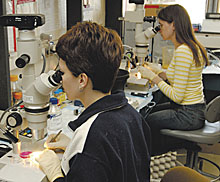Federal Grant To Help Improve
Dental School Infrastructure
 |
|
Veta Doufexi, left, and Carolyn Lucey collect tissue for culturing
at the Health Center. The two work in the lab of Dr. Mina Mina, one of the co-investigators
on a recent infrastructure enhancement grant from NIH.
|
|
Photo by Peter Morenus |
Researchers at the UConn Health Center have received a $2 million, two-year grant from the National Institutes of Health for infrastructure enhancement. The grant will enable the School of Dental Medicine to hire faculty, purchase equipment, and promote research.
The project grew from an idea developed by Susan Reisine, professor and head of the Department of Behavioral Sciences and Community Health and associate dean for research at the dental school. She hoped to return to the heady days of the 1970’s and 1980’s, when the dental school was one of the country’s top research organizations in terms of funding from the NIH and the National Institute for Dental and Craniofacial Research.
A self-study undertaken before the dental school’s recent re-accreditation provided the framework. A research strategic plan which foresaw a Center for Craniofacial Tissue Repair and Regeneration provided the motivation. An NIH request for applications for an infrastructure enhancement grant provided the opportunity. And 21st Century UConn, with its promise of $297 million over 10 years to develop and maintain the infrastructure of the Health Center, provided the fillip.
Reisine and a team wrote and submitted the proposal, and the NIH responded “Yes” in September with $2 million over two years.
“We were thrilled to receive the grant,” says Reisine. “This was a highly competitive process. Only seven were being awarded and every dental school wanted one.
“It’s a terrific opportunity for the Health Center and School of Dental Medicine,” she adds. “The research strategic plan anticipated developing a program like this within the medical and dental schools, and the infrastructure grant will help jump-start that initiative.”
The grant brings together faculty members who are well known in the fields of tissue regeneration and biomaterials and colleagues with acumen and scientific capabilities in other, related specialties. The Health Center and the University were committed ideologically to bringing such a program to fruition, and were also willing to contribute money and resources.
Grant co-investigators and their research specialties include:
- Jon Goldberg, a professor of prosthodontics and director of the Center for Biomaterials, who is involved in the development of new biomaterials, studies of structure-property relationships, surface analysis, and clinical trials of restorative dental materials;
- Dr. Mina Mina, a professor of pediatric dentistry, whose lab does research on the mechanisms regulating, and the biochemical processes that prompt, jawbone and jaw-related tissue growth;
- William Upholt, a professor of biostructure and function, whose lab investigates molecular mechanisms regulating differentiation and pattern formation during embryonic development, with particular emphasis on skeletal development in the limb and mandible.
The Health Center’s Musculoskeletal Signature Program – bone biology and biomedical engineering research initiatives, together with osteoporosis and orthopaedic translational research – perfectly complemented the Center for Craniofacial Tissue Repair and Regeneration initiative.
The grant will fund the recruitment and hire of a senior researcher and manager to become center director, an individual who will coordinate the program goals of the Center for Craniofacial Tissue Repair and Regeneration with the Musculoskeletal Signature Program. Members of the recruiting committee members hope to have the person start work in the early fall.
The grant also provides for up to half a dozen faculty members to be recruited in the dental and medical schools to support the center. The mix of scientists will bring new skills in disciplines such as craniofacial biology, translational research, epidemiology plus biostatistics to help with clinical trials.
“The grant skillfully laid out our capabilities and the situation that existed,” says Peter Robinson, dean, School of Dental Medicine. “We had planned for and were poised to proceed with creating a center dedicated to translational research and making maximum use of faculty collaboration and interdisciplinary synergy. The grant is a boon because it has materially sped up the process.”

